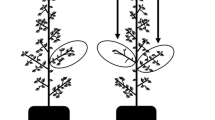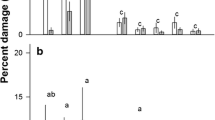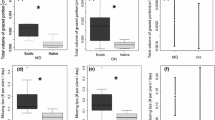Abstract
Plant resistance to herbivores can be influenced not only by the independent effects of plant genotype and environmental variation, but by interactions between the two. The main aim of this study was to assess the effects of environmental variability (nutrient treatment) on the known genetic-based expression of resistance and defensive chemistry of Eucalyptus globulus to browsing by the generalist mammalian herbivore Trichosurus vulpecula. In a captive feeding trial, we measured intake of seedlings from one relatively resistant (Blue Gum Hill) and one relatively susceptible (St Helens) population of E. globulus grown under two nutrient treatments (no fertiliser, plus fertiliser). There was a significant genotype×fertiliser interaction effect on intake of E. globulus foliage by T. vulpecula, and the predicted genetic-based resistance of the two populations was expressed only for the non-fertilised treatment. Expression of resistance largely reflected the combined and inverse effects of nitrogen and condensed tannin concentrations. The expression of plant secondary metabolite concentration differed between compounds, but in all cases the effects of plant genotype and fertiliser treatment were independent. The formylated phloroglucinol compounds differed significantly between genotypes but not between fertiliser treatments. In contrast, the effect of plant genotype on the expression of condensed tannins was weak but they were significantly reduced by fertiliser. Essential oils were influenced by both plant genotype and fertiliser treatment and were significantly higher in the fertilised seedlings than in the non-fertilised seedlings. This study highlights interactive effects of plant genotype and environment in influencing the phenotypic expression of resistance in a eucalypt species to a mammalian browser. It also demonstrates that this interactive effect is the net result of independent effects of genotype and environment on plant chemistry and finally, that different groups of compounds within a plant can respond very differently to variation in environmental conditions.

Similar content being viewed by others
References
Belovsky GE, Schmitz OJ (1991) Mammalian herbivore optimal foraging and the role of plant defenses. In: Palo RT, Robbins CT (eds) Plant defenses against mammalian herbivory. CRC, Boca Raton, Fla., pp 1–28
Berenbaum MR, Zangerl AR, Nitao JK (1986) Constraints on chemical coevolution: wild parsnips and the parsnip webworm. Evolution 40:1215–1228
Bjorkman C, Kyto M, Larsson S, Niemela P (1998) Different responses of two carbon-based defences in Scots pine needles to nitrogen fertilization. Ecoscience 5:502–507
Bryant JP, Clausen TP, Reichardt PB, McCarthy MC, Werner RA (1987) Effect of nitrogen fertilization upon the secondary chemistry and nutritional value of quaking aspen (Populus tremuloides Michx.) leaves for the large aspen tortrix [Choristoneura conflictana (Walker)]. Oecologia 73:513–517
Burns AE, Gleadow RM, Woodrow IE (2002) Light alters the allocation of nitrogen to cyanogenic glycosides in Eucalyptus cladocalyx. Oecologia 133:288–294
Campbell DR, Waser NM (2001) Genotype-by-environment interaction and the fitness of plant hybrids in the wild. Evolution 55:669–676
Close DC, McArthur C (2002) Rethinking the role of many plant phenolics - protection from photodamage not herbivores? Oikos 99:166–172
Close DC, Beadle CL, Clasen QC (2002) Physical and nutritional characteristics and performance after planting of Eucalyptus globulus Labill. seedlings from ten nurseries: implications for seedling specifications. Aust For 66:145–152
Close DC, McArthur C, Paterson S, Fitzgerald H, Walsh A, Kincade T (2003) Photoinhibition: a link between effects of the environment on eucalypt seedling leaf chemistry and herbivory. Ecology 84:2952–2966
Cobb NS, Trotter RT III, Whitham TG (2002) Long-term sexual allocation in herbivore resistant and susceptible pinyon pine (Pinus edulis). Oecologia 130:78–87
Coley PD, Bryant JP, Chapin FS III (1985) Resource availability and plant antiherbivore defense. Science 230:895–899
Cork SJ, Catling PC (1996) Modelling distributions of arboreal and ground-dwelling mammals in relation to climate, nutrients, plant chemical defences and vegetation structure in the eucalypt forests of southeastern Australia. For Ecol Manage 85:163–175
Cunningham SA, Summerhayes B, Westoby M (1999) Evolutionary divergences in leaf structure and chemistry, comparing rainfall and soil nutrient gradients. Ecology 69:569–588
Dungey HS, Potts BM (2002) Susceptibility of some Eucalyptus species and their hybrids to possum damage. Aust For 65:23–30
Dungey HS, Potts BM, Whitham TG, Li H-F (2000) Plant genetics affects arthropod community richness and composition: evidence from a synthetic eucalypt hybrid population. Evolution 54:1938–1946
Dutkowski GW, Potts BM (1999) Geographic patterns of genetic variation in Eucalyptus globulus ssp. globulus and a revised racial classification. Aust J Bot 47:237–263
Edwards PB, Wanjura WJ, Brown WV, Dearn JM (1990) Mosaic resistance in plants. Nature 347:434
Fritz RS (1999) Resistance of hybrid plants to herbivores: genes, environment, or both? Ecology 80:382–391
Gianoli E (2002) A phenotypic trade-off between constitutive defenses and induced responses in wheat seedlings. Ecoscience 9:482–488
Gouinguene SP, Turlings TCJ (2002) The effects of abiotic factors on induced volatile emissions in corn plants. Plant Physiol 129:1296–1307
Graham HD (1992) Stabilization of the Prussian blue color in the determination of polyphenols. J Agric Food Chem 40:801–805
Hagerman AE (1995) Tannin analysis, 2nd edn. Miami University Press, Oxford, Ohio
Hartley SE, Iason GR, Duncan AJ, Hitchcock D (1997) Feeding behaviour of red deer (Cervus elaphus) offered Sitka spruce saplings (Picea sitchensis) grown under different light and nutrient regimes. Funct Ecol 11:348–357
Herms DA, Mattson WJ (1992) The dilemma of plants: to grow or defend. Q Rev Biol 67:283–335
Hjältén J, Ericson L, Roininen H (2000) Resistance of Salix caprea, S. phylicifolia, and their F1 hybrids to herbivores and pathogens. Ecoscience 7:51–56
Holton MK, Lindroth RL, Nordheim EV (2003) Foliar quality influences tree–herbivore–parasitoid interactions: effects of elevated CO2, O3, and plant genotype. Oecologia 137:233–244
Hwang S-Y, Lindroth RL (1997) Clonal variation in foliar chemistry of aspen: effects on gypsy moths and forest tent caterpillars. Oecologia 111:99–108
Keinanen M, Julkunen-Tiitto R, Mutikainen P, Walls M, Ovaska J, Vapaavuori E (1999) Trade-offs in phenolic metabolism of silver birch: effects of fertilization, defoliation, and genotype. Ecology 80:1970–1986
Kopper BJ Lindroth RL (2003) Effects of elevated carbon dioxide and ozone on the phytochemistry of aspen and performance of an herbivore. Oecologia 134:95–103
Koricheva J, Larsson S, Haukioja E, Keinänen M (1998) Regulation of woody plant secondary metabolism by resource availability: hypothesis testing by means of meta-analysis. Oikos 83:212–226
Laitinen J, Rousi M, Tahvanainen J (2002) Growth and hare, Lepus timidus, resistance of white birch, Betula pendula, clones grown in different soil types. Oikos 99:37–46
Lawler IR, Foley WJ, Woodrow IE, Cork SJ (1997) The effects of elevated CO2 atmospheres on the nutritional quality of Eucalyptus foliage and its interaction with soil nutrient and light availability. Oecologia 109:59–68
Lawler IR, Foley WJ, Eschler BM (2000) Foliar concentration of a single toxin creates habitat patchiness for a marsupial folivore. Ecology 81:1327–1338
Lowman MD Heatwole H (1992) Spatial and temporal variability in defliation of Australian eucalypts. Ecology 73:129–142
Lowther JR (1980) Use of a single sulphuric acid–hydrogen peroxide digest for the analysis of pinus radiata needles. Soil Sci Plant Anal 11:175–188
Marquis RJ (1990) Genotypic variation in leaf damage in Piper arieianum (Piperaceae) by a multispecies assemblage of herbivores. Evolution 44:104–120
Marsh KJ, Wallis IR, Foley WJ (2003) The effect of inactiviating tannins on the intake of Eucalyptus foliage by a specialist Eucalyptus folivore (Pseudocheirus peregrinus) and a generalist herbivore (Trichosurus vulpecula). Aust J Zool 51:31–42
Mazer SJ Damuth J (2001) Evolutionary significance of variation. In: Fox CW, Roff DA, Fairburn DJ (eds) Evolutionary Ecology. Concepts and case studies. Oxford University Press, New York, pp 16–28
McArthur C, Goodwin A, Turner S (2000) Preferences, selection and damage to seedlings under changing availability by two marsupial herbivores. For Ecol Manage 139:157–173
McArthur C, Marsh NR, Close DC, Walsh A, Paterson S, Fitzgerald H, Davies NW (2003) Nursery conditions affect seedling chemistry, morphology and herbivore preferences for Eucalyptus nitens. For Ecol Manage 176:585–594
Mihaliak CA, Couvet D, Lincoln DE (1989) Genetic and environmental contributions to variation in leaf mono- and sesquiterpenes to Heterotheca subaxillaris. Biochem Syst Ecol 17:529–533
Mopper S, Mitton JB, Whitham TG, Cobb NS, Christensen KM (1991) Genetic differentiation and heterozygosity in Pinyon pine associated with resistance to herbivory and environmental-stress. Evolution 45:989–999
Mutikainen P, Walls M, Ovaska J, Keinänen M, Julkunen-Tiitto R, Vapaavuori E (2000) Herbivore resistance in Betula pendula: effect of fertilization, defoliation, and plant genotype. Ecology 81:49–65
O’Reilly-Wapstra JM, McArthur C, Potts BM (2002) Genetic variation in resistance of Eucalyptus globulus to marsupial browsers. Oecologia 130:289–296
O’Reilly-Wapstra JM, McArthur C, Potts BM (2004) Linking plant genotype, plant defensive chemistry and mammal browsing in a Eucalyptus species. Funct Ecol 18:677–684
O’Reilly-Wapstra JM, Potts BM, McArthur C, Davies N, Tilyard P (2004) Inheritance of resistance to mammalian herbivores and of plant defensive chemistry in a Eucalyptus species. J Chem Ecol (in press)
Osier TL Lindroth RL (2001) Effects of genotype, nutrient availability, and defoliation on aspen phytochemistry and insect performance. J Chem Ecol 27:1289–1313
Porter LJ, Hrstich LN, Chan BG (1986) The conversion of procyanidins and prodelphinidins to cyanidin and delphinidin. Phytochemistry 25:223–230
Powell JS, Raffa KF (1999) Sources of variation in concentration and composition of foliar monoterpenes in tamarack (Larix laricina) seedlings: roles of nutrient availability, time of season, and plant architecture. J Chem Ecol 25:1771–1797
Rapley L, Allen GR, Potts BM (2004) Genetic variation in the susceptibility of Eucalyptus globulus to autumn gum moth Mnesampela privata (Lepidoptera: Geometridae) oviposition. For Ecol Manage 194:169–175
Ratkowsky DA, Evans MA, Alldredge JR (1993) Cross-over experiments. Dekker, New York
Raymond CA (1995) Genetic variation in Eucalyptus regnans and Eucalyptus nitens for levels of observed defoliation caused by the Eucalyptus leaf beetle, Chrysophtharta bimaculata Oliver, in Tasmania. For Ecol Manage 72:21–29
SAS Institute (1989) SAS/STAT user’s guide, 4th edn. SAS Institute, Cary, N.C.
SAS Institute (1997) SAS/STAT software: changes and enhancements through release 6.12. SAS Institute, Cary, N.C.
Singer MC, Parmesan C (1993) Sources of variations in patterns of plant-insect association. Nature 361:251–253
Steinbauer MJ, Schiestl FP, Davies NW (2004) Monoterpenes and epicuticular waxes help female Autumn Gum Moth differentiate between waxy and glossy Eucalyptus leaves and leaves of different ages. J Chem Ecol 30:1117–1142
Strengbom J, Olofsson J, Witzell J, Dahlgren J (2003) Effects of repeated damage and fertilization on palatability of Vaccinium myrtillus to grey sided voles, Clethrionomys rufocanus. Oikos 103:133–141
Traw MB (2002) Is induction response negatively correlated with constitutive resistance in black mustard? Evolution 56:2196–2205
Wallis IR, Herlt AJ, Eschler BM, Takasaki M, Foley WJ (2003) Quantification of sideroxylonals in Eucalyptus foliage by high-performance liquid chromatography. Phytochem Anal 14:360–365
Williams JE, Brooker MIH (1997) Eucalypts: an introduction. In: Williams JE, Woinarski JCZ (eds) Eucalypt ecology individuals to ecosystems. Cambridge University Press, Cambridge, pp 1–15
Acknowledgements
Animals were caught and maintained under the University of Tasmania Animal Ethics Committee, project no. A6655; and Parks and Wildlife Service permit no. FA03102. We would like to thank Kelsey Joyce and Gunns for the seed stock. We thank Ann Wilkinson for running the colorimetric analysis of the nitrogen digests, Dugald Close for advice on fertiliser regimes, Ian Cummings and Tracey Jackson for assistance with seed germination and Hugh Fitzgerald for assistance with aspects of the feeding trials and chemical analyses. This project was funded by the University of Tasmania Postgraduate Scholarship and the CRC for Sustainable Production Forestry.
Author information
Authors and Affiliations
Corresponding author
Rights and permissions
About this article
Cite this article
O’Reilly-Wapstra, J.M., Potts, B.M., McArthur, C. et al. Effects of nutrient variability on the genetic-based resistance of Eucalyptus globulus to a mammalian herbivore and on plant defensive chemistry. Oecologia 142, 597–605 (2005). https://doi.org/10.1007/s00442-004-1769-y
Received:
Accepted:
Published:
Issue Date:
DOI: https://doi.org/10.1007/s00442-004-1769-y




